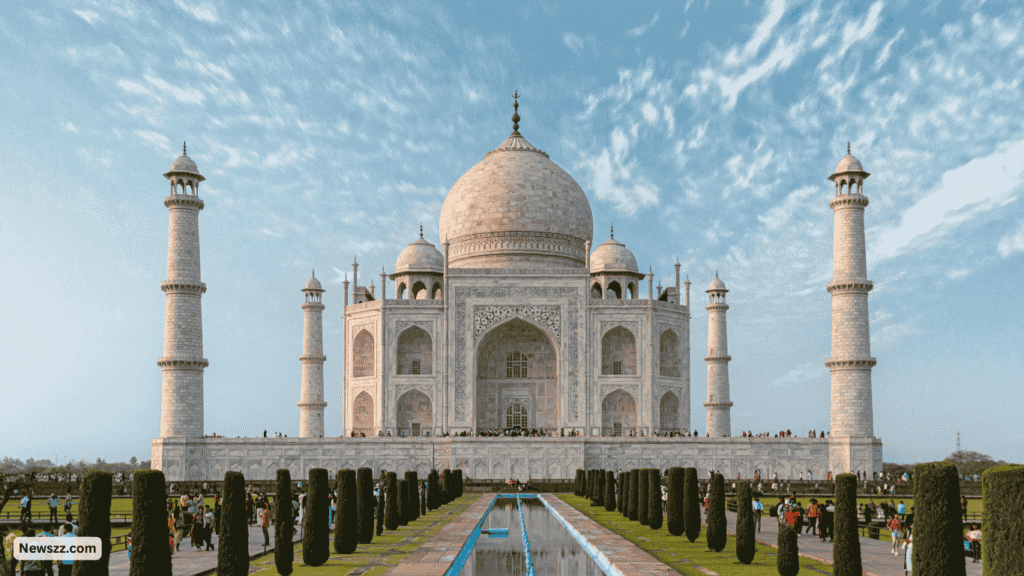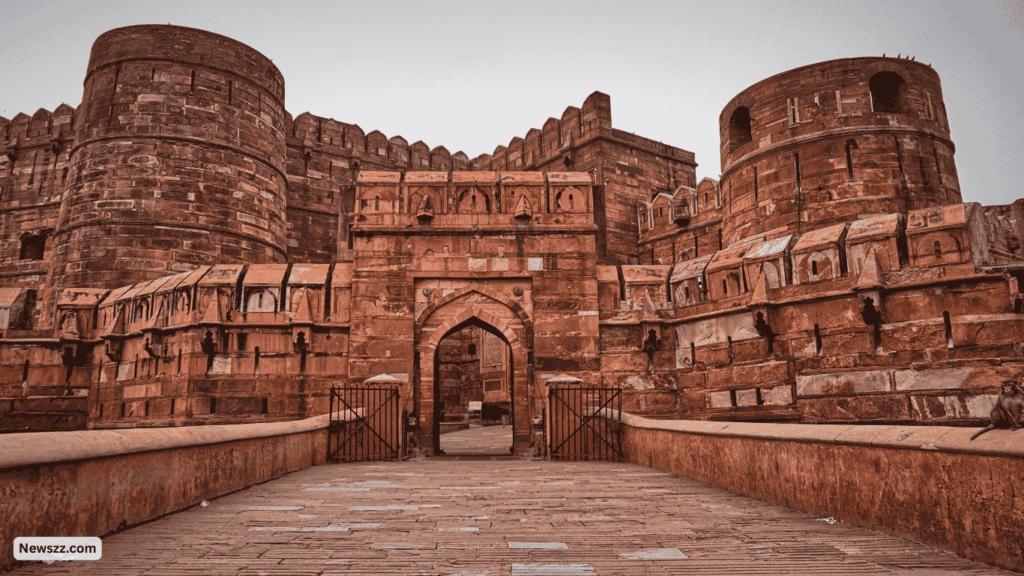Introduction to Agra
Travel Guide to Agra, the crown jewel of India’s Golden Triangle, is a city that seamlessly blends history, culture, and romance. Famous around the world as the home of the Taj Mahal, Agra attracts millions of travelers every year who long to experience the grandeur of Mughal architecture. Situated on the banks of the Yamuna River in Uttar Pradesh, Agra has been a historical seat of power for the Mughal dynasty, leaving behind architectural marvels, bustling bazaars, and a rich cultural legacy.

But Agra is more than just the Taj Mahal. Within the city and its surroundings, you’ll find magnificent forts, vibrant local markets, and culinary delights that speak to its Mughal past. Whether you are a history enthusiast, a photographer, or someone seeking a romantic escape, Agra promises an unforgettable journey through time.
Agra is not only accessible but also well connected for travelers from Delhi, Jaipur, and beyond, making it a perfect stop on your North India adventure. From stunning sunrise views at the Taj Mahal, mesmerizing Mughal-era gardens, to hidden gems tucked away in busy lanes, Agra offers experiences that captivate both first-time visitors and seasoned travelers. This ultimate travel guide to Agra will cover everything you need to plan your trip—from historical wonders and adventure spots to food, festivals, and practical tips—ensuring your journey is seamless and memorable.
Best Cultural and Historical Places in Agra
Agra’s glory rests in its historical and cultural treasures, many of which are UNESCO World Heritage Sites. The Taj Mahal, an eternal symbol of love built by Emperor Shah Jahan in memory of his wife Mumtaz Mahal, is undoubtedly the centerpiece. Watching the white marble monument change hues with the rising and setting sun is an unforgettable experience. Early morning visits are highly recommended for fewer crowds and ethereal views.

The Agra Fort is another architectural marvel that offers insights into the grandeur of the Mughal Empire. With its red sandstone walls enclosing palaces, mosques, and courtyards, a walk here feels like revisiting royal Mughal life. Similarly, Fatehpur Sikri, a short drive from Agra, is often called the “Ghost City” because it was abandoned soon after construction, but its stunning palaces and courtyards remain perfectly preserved.
For those seeking spiritual discovery, the Itimad-ud-Daulah’s Tomb, often nicknamed the “Baby Taj,” boasts intricate marble inlay work that foreshadowed the craftsmanship of the Taj Mahal. The city is also home to the Mehtab Bagh, a Mughal-era garden that provides the perfect vantage point to admire the Taj Mahal from across the Yamuna River.
Beyond the famous landmarks, Agra is dotted with smaller gems like Akbar’s Tomb in Sikandra, an elegant fusion of Hindu, Islamic, and Persian artistry. Exploring these sites gives you a deeper appreciation of Mughal heritage and the city’s role in shaping India’s history. Whether you’re walking through grand fortifications or quiet Mughal gardens, Agra immerses you in layers of time, culture, and unmatched architectural brilliance.
Adventure Activities and Nature Spots in Agra
Although known predominantly for its monuments, Agra also offers unique adventure and nature-based experiences for those willing to explore beyond the classic tourist trail. If you crave greenery and calm, a visit to the Mehtab Bagh is ideal, not only as a viewpoint but also as a place to enjoy a leisurely walk by the river with the Taj Mahal in sight—perfect for photographers and nature lovers alike.
Birdwatchers will find paradise at the Keetham Lake (Sur Sarovar Bird Sanctuary), located about 20 kilometers from Agra. Home to over 160 species of migratory and resident birds, including the sarus crane, this spot is perfect for a day outdoors. The lush surroundings provide a refreshing break from the hustle of city life.

For adventure seekers, cycling tours through the city or along the trails leading toward Fatehpur Sikri offer an exciting way to experience Agra’s heritage. Walking tours through old city lanes allow you to explore hidden bazaars, traditional crafts, and lesser-known Mughal-style havelis.
If you prefer tranquility, the Yamuna Riverfront is another spot where you can enjoy boat rides, providing stunning reflections of Agra’s monuments during sunset. Some local operators even offer guided tours that combine history lessons with scenic boat rides.
For families, the Wildlife SOS Elephant and Bear Rescue Center, located near Mathura (a short drive from Agra), is a rewarding excursion. It promotes eco-tourism and provides a humane way to learn about India’s efforts in wildlife conservation. With its blend of natural beauty, adventure, and cultural immersion, Agra proves it offers much more than just monuments.
Food and Local Cuisine in Agra
Agra is not only a city of monuments but also a food lover’s paradise. The Mughal influence in the region has left behind a rich culinary legacy that continues to tantalize taste buds today. From royal Mughlai dishes to sweet street-side indulgences, Agra’s food scene is a must-experience for every traveler.
One dish you absolutely cannot miss is Agra ka Petha, a translucent sweet made from ash gourd and sugar, often flavored with saffron, rose, or nuts. Shops like Panchi Petha are famous for offering different varieties, including chocolate and paan flavors. Another delightful snack is the Bedai with Aloo Sabzi, a local breakfast favorite that you’ll find in bustling lanes near Jama Masjid. Crisp, deep-fried bread served with spicy potato curry is often chased down with a glass of lassi or hot jalebis.
For a taste of Mughlai grandeur, head to one of Agra’s old restaurants and try Mutton Korma, Butter Chicken, and Mughlai Biryani. The rich gravies, seasoned with aromatic spices, reflect the regal traditions of the Mughal kitchens. Pinch of Spice and Dasaprakash are popular among tourists, while hidden gems in Sadar Bazar and old marketplaces offer authentic street-style kebabs and curries.
Tea lovers will enjoy small roadside stalls serving masala chai, while adventurous eaters can savor tangy chaats at local food corners. Don’t forget to try the lesser-known Dal Moth, a savory lentil snack indigenous to Agra.
Exploring local food not only satisfies hunger but also connects you to the city’s daily rhythm. From bustling bazaars filled with the aroma of spices to heritage eateries that retell the Mughal past, Agra’s cuisine is a journey in itself.
Nightlife and Festivals in Agra
Although Agra may not be as famous as Goa or Mumbai for nightlife, it offers unique after-dark experiences that combine history, culture, and festivity. The city’s charm lies in its ability to entertain visitors well beyond its monuments.
For evening entertainment, many hotels host cultural performances, including classical Kathak dances and music sessions that celebrate Mughal traditions. Rooftop cafés and lounges near the Taj Mahal area provide mesmerizing views while sipping on cocktails or mocktails. Some travelers find sunset boat rides on the Yamuna River to be the perfect way to wind down after a day of sightseeing.
Agra also lights up during its festivals. The Taj Mahotsav, held every February, is one of the grandest festivals, celebrating art, craft, cuisine, and cultural performances from different parts of India. Visitors can shop for handicrafts, watch folk dances, and enjoy street food—all in one place. Ram Barat and Diwali transform the city with lights, decorations, and processions, giving visitors a glimpse into local traditions.
For a modern take on nightlife, head to zones like Sadar Bazar, TDI Mall, or hotel bars that offer lively atmospheres with music and good food. While Agra is not a party capital, it offers a mix of heritage evenings, local folk festivals, and cozy dining encounters under starlit skies, perfectly balancing cultural exploration with contemporary leisure.
Accommodation and Getting Around in Agra
Agra caters to every kind of traveler, from luxury seekers to budget explorers. For those seeking a royal stay, opulent properties like The Oberoi Amarvilas, located close to the Taj Mahal, offer unparalleled luxury with rooms that provide direct views of the monument. Similarly, ITC Mughal is another five-star option that captures the essence of Mughal architecture blended with modern comfort.
Mid-range travelers have plenty of boutique hotels and heritage havelis to choose from. Many of these properties are located in quieter neighborhoods and boast charming courtyards, personalized service, and proximity to key attractions. Budget travelers will find abundant hostels, guesthouses, and affordable lodges, especially around Fatehabad Road and Taj Ganj, which are backpacker-friendly neighborhoods.
Getting around Agra is fairly convenient. Auto-rickshaws and cycle-rickshaws remain popular and inexpensive ways of navigating the city. For longer distances or day trips (such as Fatehpur Sikri), taxis and app-based cab services like Ola and Uber are available. You can also hire private guides or join walking tours to explore hidden lanes and bazaars.
A unique option for local exploration is tonga rides (horse carriages), which are still used around the Taj Mahal area and provide a touch of old-world charm. If you’re up for a little adventure, cycling tours are another great way to experience the city.
Choosing accommodation based on your travel style ensures comfort, while efficient transportation options make exploring Agra smooth and enjoyable.
Practical Travel Tips for Visiting Agra
When planning your trip to Agra, a few practical tips can help you make the most of your experience while avoiding common pitfalls.
- Best Time to Visit: The ideal months are October to March, when the weather is pleasant. Summers can be extremely hot, while the monsoon season brings humidity—but fewer crowds.
- Entry Tickets: Tickets for the Taj Mahal are available online and are strongly recommended to save time. Foreign tourists pay a higher fee, but skip-the-line access often helps avoid long queues.
- Early Mornings & Evenings: Visiting the Taj Mahal at sunrise offers not only lighter crowds but also spectacular photography opportunities. Mehtab Bagh at sunset is another magical spot.
- Comfortable Footwear: With so much walking around expansive forts and gardens, sturdy and comfortable shoes are a must.
- Respect Local Etiquette: While Agra is tourist-friendly, it’s best to dress modestly, especially when visiting religious sites.
- Local Souvenirs: Agra is famous for marble inlay work, leather goods, brassware, and miniature Taj mementos—Sadar Bazar and Kinari Bazar are great places to shop.
- Stay Hydrated & Be Cautious with Street Food: While local food is delightful, stick to popular and hygienic outlets to avoid stomach troubles. Bottled drinking water is advisable.
- Transportation Safety: Fix fares with auto-rickshaw drivers before starting or prefer app-based cabs. Always keep some small denomination cash handy.
By being mindful of these tips, you can enjoy Agra with fewer interruptions, ensuring that your trip remains hassle-free, enriching, and memorable.
Sample Itinerary for Agra
Planning your trip with a well-thought-out itinerary ensures you soak in all of Agra’s magic without rushing. Here’s a 2-day itinerary that blends history, culture, food, and leisure.
Day 1 – Heritage & Iconic Views
- Start your morning early with a sunrise visit to the Taj Mahal.
- Stop by a local eatery for Bedai and Jalebi breakfast.
- Explore the Agra Fort, a UNESCO site full of history and grandeur.
- Enjoy lunch at a Mughlai restaurant like Pinch of Spice.
- Spend your afternoon at the Itimad-ud-Daulah Tomb (Baby Taj).
- End the day at Mehtab Bagh to witness the Taj Mahal at sunset.
Day 2 – Beyond the Taj
- Take an excursion to Fatehpur Sikri, around 40 km from Agra. Explore monuments like Buland Darwaza and Panch Mahal.
- Return to Agra and enjoy local street food or relax with shopping in Sadar Bazar.
- Visit the Keetham Lake or take a short trip to the Wildlife SOS rescue center.
- Wind down with a cultural folk dance performance or rooftop dinner overlooking the Taj Mahal.
For longer stays, add nearby cities like Mathura, Vrindavan, or Bharatpur Bird Sanctuary to extend your cultural and natural exploration.
Conclusion
Agra is a city that transcends time. While most come for the Taj Mahal, they often leave enamored by its forts, culture, food, and vibrant local lifestyle. Whether you’re chasing sunrise views of the marble wonder, savoring street food in Old Agra, exploring Mughal gardens, or losing yourself in cultural festivals, Agra ensures every traveler finds something extraordinary.
This Ultimate Travel Guide to Agra is your companion to uncovering its iconic sites, hidden gems, and practical travel hacks, making sure your journey is as enriching as it is memorable.
